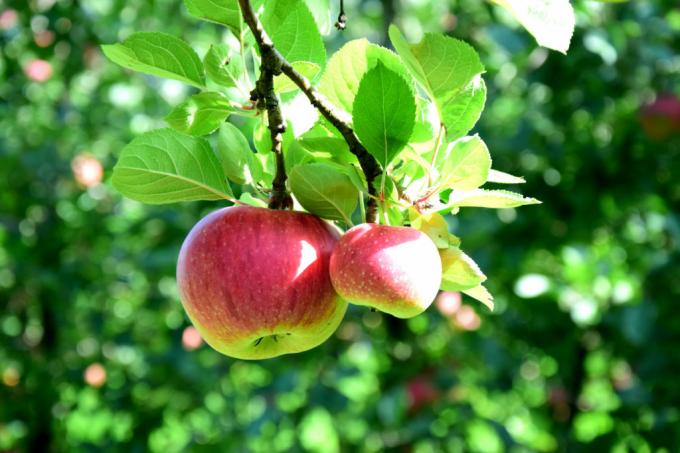The ‘Rote Berlepsch’ is an old, tasty and proven apple variety. We explain the properties of the apple tree and the fruit of the ‘Red Berlepsch’ and what you can consider during cultivation, care and harvest.

The ‘Rote Berlepsch’ is an apple variety with many qualities and equally high demands. Also known as the Hohenzollern apple, it is closely related to the ‘Goldrenette Freiherr von Berlepsch‘Related from which it is derived. ‘Roter Berlepsch’ can be cultivated as a high trunk, half trunk or trellis, but requires an almost perfect location and professional care for good yields.
contents
- Roter Berlepsch: profile
- Origin and history of the apple
- Properties and taste of the Red Berlepsch
- Special features of cultivation and care
- Apple variety ‘Roter Berlepsch’: harvest time and use
Roter Berlepsch: profile
| fruit | small to medium in size; red body color |
| taste | juicy, sweet and sour |
| Yield | irregular |
| Harvest time | October to December |
| Ripe for enjoyment | December to March |
| Shelf life | Well; Apples harvested early can be stored until February |
| growth | initially strong, later significantly weaker |
| climate | mild |
| Diseases and pests | susceptible to fruit tree cancer on soils that are too heavy |
Origin and history of the apple
The apple variety ‘Roter Berlepsch’ is a mutant of the variety ‘Baron von Berlepsch‘. That means: A single shoot or branch was created through a random error in the reproduction of the genetic material during cell division with special properties, which was then propagated vegetatively - i.e. asexually, for example via cuttings or Refinement. This accidental genetic change was the increased appearance of the red body color. However, nothing changed in the taste or other properties of the apple. The ‘Rote Berlepsch’ is a nice chance find!
By the way: The ‘Freiherr von Berlepsch’ and the Kaiser Wilhelm ’variety were examined in molecular genetics in 2010 and it was found that they do not differ in any way. The discovery sites of the "two" varieties - Nesselrode and Grevenbroich - are only 50 km apart. It is therefore assumed that the variety first appeared in Grevenbroich as a random seedling in 1830 and was unknowingly "discovered" and named again in 1864.
Properties and taste of the Red Berlepsch
Just like its genetic origin, the ‘Rote Berlepsch’ also has small or medium-sized fruits and a fruity aroma in the firm, yellowish-white pulp. The apple tree also grows very strongly at the beginning, but later much weaker. The crowns are well branched, only the mid-late flowering is unfortunately a bit sensitive to frost. The resulting flower damage often leads to highly fluctuating yields. In addition, the ‘Rote Berlepsch’ is susceptible to various diseases in unsuitable locations.
You can find out more about the properties of the two Berlepsch apples in the variety article ‘Baron von Berlepsch‘Read.
Special features of cultivation and care
The ‘Rote Berlepsch’, like its progenitor, is a demanding journeyman: For good, high-quality yields, a climate is milder The location is a must and the soil must also hardly be of the ideal "moist, deep, permeable, sandy-loamy and nutrient-rich" differ. Grown in poor locations, it is easy for flowers and wood to freeze, fruit fall, irregular yields, reduced growth and an increased incidence of diseases.
On the other hand, the ‘Rote Berlepsch’ can be raised to be an espalier fruit because it grows in a straight line. The classic cut in a pyramidal shape or as a spindle is difficult to implement because of the strong growth on the shoots and requires annual, well-guided cuts.

Suitable pollinators are: ‘Discovery’, ‘Cox orange‘,‘ Klarapfel ’,‘James Grieve‘,‘ Jonathan ’and the Pineapple Renette’.
Tip: Not every apple variety has such a high nutritional requirement as the ‘Rote Berlepsch’. With a primarily organic fertilizer like Plantura Organic universal fertilizer you can satisfy this hungry strain without over stimulating vegetative growth at the expense of fruiting.
Apple variety ‘Roter Berlepsch’: harvest time and use
As a winter apple, the ‘Rote Berlepsch’ is ready to be harvested from October to December. Fruits that are harvested early and not fully ripe can be kept cool until February. What should be emphasized about the ‘Roten Berlepsch’ is that its taste changes only minimally during storage and that the taste of the variety can still be rated as excellent. If the ‘Rote Berlepsch’ is stored too warm, it unfortunately tends to wilt very much, so it shrinks quickly. What the ‘Red Belepsch’ can be used for in addition to fresh consumption can be found in the variety article for ‘Baron von Berlepsch' find out.
Have you fallen in love with the Roten Berlepsch and want to go straight to planting? Here we explain Apple tree planting in 10 steps.



